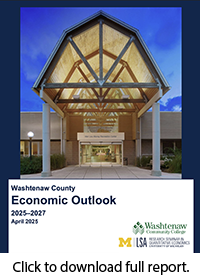
The 40th annual Washtenaw County Economic Outlook, commissioned by Washtenaw Community College, was presented today at the President’s Leadership Recognition Luncheon.
WCC President Dr. Rose B. Bellanca hosted nearly 200 business, industry, government and community leaders to thank them for their support of the college, which educates more than 21,000 students annually, fulfilling its role as a regional economic engine and hub for talent development.
 In their new report, economists and authors Gabriel Ehrlich, Ph.D., and Donald Grimes
of the University of Michigan’s Research Seminar in Quantitative Economics, say Washtenaw County faces significant economic headwinds over the next few years,
but its highly educated workforce, diverse employment base and strong institutional anchors
will provide important buffers against volatility.
In their new report, economists and authors Gabriel Ehrlich, Ph.D., and Donald Grimes
of the University of Michigan’s Research Seminar in Quantitative Economics, say Washtenaw County faces significant economic headwinds over the next few years,
but its highly educated workforce, diverse employment base and strong institutional anchors
will provide important buffers against volatility.
Still, the county’s outlook for the next two and a half years is “notably downshifted” from last year’s robust forecast.
Ehrlich and Grimes anticipate employment growth will continue through 2027 but at a slower pace than in recent years.
“The economic landscape has shifted dramatically since our last forecast for Washtenaw County. While we celebrated the likelihood of a ‘soft landing’ last year, we now face significant headwinds at the national, state and local levels that have moderated our outlook,” the new report says.
“Both the national and local economies, which showed encouraging resilience through much of 2023 and early 2024, have since displayed signs of strain. Employment growth has slowed, and unemployment rates have begun to trend upward. Combined with substantial policy uncertainty surrounding tariffs and the prospect of reduced federal research and education funding, Washtenaw County will find itself navigating a challenging road over the next two and a half years.”
RELATED: Photo Gallery (More Photos Coming Soon)
Tariffs are expected to remain disruptive in the short run as supply chains adjust, according to the report. While Washtenaw County may be largely protected from direct tariff impacts within the automotive sector, secondary impacts could be felt due to broader economic ties to the auto industry.
A significant concern is the prospect of higher education research funding cuts, according to the economists.
“The proposed reductions in federal research funding are a potentially greater threat to Washtenaw County due to the importance of the region’s higher education sector. With less funding to support research payrolls, we forecast state government employment, where the University of Michigan and Eastern Michigan University are classified, to decline by roughly 2,000 jobs relative to trend over the next two years,” the report says.
The report tempers a guarded outlook with relative optimism, however.
Economists project the Federal Reserve to continue cutting interest rates over the next two years. Importantly, they project large personal and corporate tax cuts beginning in 2026 amounting to $200 billion per year, outweighing the revenues collected by tariffs and “thus providing a substantial short-term stimulus.”
Overall, the economists forecast the total number of jobs in Washtenaw County to grow by 0.2 percent in 2025, followed by 0.4 percent in 2026 and 0.6 percent in 2027. That growth would be well below the pre-pandemic average of 1.9 percent annually from 2010–2019. Meanwhile, the county’s labor force is projected to steadily expand to the point it exceeds pre-pandemic levels by 6.7 percent in 2027. Washtenaw’s jobless rate, which rose from 3.5 percent last May to 4.7 percent in January, is projected to stabilize at about 4.4 percent over the forecast horizon. Additionally, three more years of real wage growth, though modest, is expected for the county.
Ehrlich is director of the University of Michigan’s Research Seminar in Quantitative Economics. He is a frequent commentator on the national and regional economic outlook and has published widely in academic journals. As RSQE director, Ehrlich oversees forecasts of the U.S. and Michigan economies, and he presents regularly to the Michigan Legislature and Governor and across the state about Michigan’s economic and fiscal prospects. He previously worked as an economist at the Congressional Budget Office.
Grimes has been engaged in economic forecasting for state and local governments for 40 years, including for many years analyzing policy and evaluating economic strategies with the Michigan departments of Transportation and Treasury and the Michigan Economic Development Corporation. He is co-director of a project to generate long-term economic and demographic projections for all of the counties of Michigan.
Jacob T. Burton and Michael R. McWilliams from the U-M Research Seminar in Quantitative Economics also worked on the forecast.
Tags: Economic Outlook, President's Leadership Recognition Luncheon
